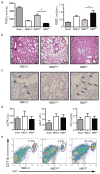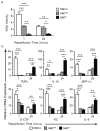Maintenance of IKKβ activity is necessary to protect lung grafts from acute injury
- PMID: 21293322
- PMCID: PMC4020590
- DOI: 10.1097/TP.0b013e31820ba2a0
Maintenance of IKKβ activity is necessary to protect lung grafts from acute injury
Abstract
Background: Signaling pathways that target I-κB kinase β (IKKβ) activation stimulate the expression of nuclear factor (NF)-κB-dependent genes and are thus believed to primarily promote inflammation and injury in solid organ grafts.
Methods: We examined the role of IKKβ in a mouse model of lung transplantation-mediated ischemia-reperfusion injury using NF-κB essential modulator (NEMO)-binding domain (NBD) peptide to pharmacologically inhibit IKK activation. As myeloid cells are primarily responsible for the production of acute inflammatory mediators after lung transplantation, we also investigated the effects of myeloid cell-specific IKKβ gene deletion on acute lung graft injury by transplanting mutant mice.
Results: When NBD was administered at a dose that partially inhibits IKKβ activation, we observed attenuated lung graft injury and blunted expression of intragraft proinflammatory mediators. Surprisingly, when the dose of NBD was increased to a level that ablates intragraft IKKβ activation, graft inflammation, and injury were significantly worse compared with recipients treated with control peptide. Similar to lung recipients with pharmacologically ablated IKKβ activity, donor-recipient transplant combinations with a myeloid cell-specific IKKβ gene deletion had marked intragraft inflammation and poor lung function.
Conclusions: Our data show maintenance of IKKβ activity is critical for promoting graft homeostasis with important implications for targeting NF-κB-dependent signaling pathways for treating acute lung injury.
Figures





Similar articles
-
Novel non-peptide small molecules preventing IKKβ/NEMO association inhibit NF-κB activation in LPS-stimulated J774 macrophages.Biochem Pharmacol. 2016 Mar 15;104:83-94. doi: 10.1016/j.bcp.2016.01.008. Epub 2016 Jan 14. Biochem Pharmacol. 2016. PMID: 26776306
-
NEMO-binding domains of both IKKalpha and IKKbeta regulate IkappaB kinase complex assembly and classical NF-kappaB activation.J Biol Chem. 2009 Oct 2;284(40):27596-608. doi: 10.1074/jbc.M109.047563. Epub 2009 Aug 7. J Biol Chem. 2009. PMID: 19666475 Free PMC article.
-
Peptidyl arginine deiminase-4 exacerbates ischemic AKI by finding NEMO.Am J Physiol Renal Physiol. 2019 Jun 1;316(6):F1180-F1190. doi: 10.1152/ajprenal.00089.2019. Epub 2019 Apr 3. Am J Physiol Renal Physiol. 2019. PMID: 30943066 Free PMC article.
-
Regulation and function of IKK and IKK-related kinases.Sci STKE. 2006 Oct 17;2006(357):re13. doi: 10.1126/stke.3572006re13. Sci STKE. 2006. PMID: 17047224 Review.
-
IkappaB kinase beta (IKKbeta/IKK2/IKBKB)--a key molecule in signaling to the transcription factor NF-kappaB.Cytokine Growth Factor Rev. 2008 Apr;19(2):157-65. doi: 10.1016/j.cytogfr.2008.01.006. Epub 2008 Mar 4. Cytokine Growth Factor Rev. 2008. PMID: 18308615 Review.
Cited by
-
Nuclear factor-kappa-B signaling in lung development and disease: one pathway, numerous functions.Birth Defects Res A Clin Mol Teratol. 2014 Mar;100(3):202-16. doi: 10.1002/bdra.23233. Epub 2014 Mar 17. Birth Defects Res A Clin Mol Teratol. 2014. PMID: 24639404 Free PMC article. Review.
-
Report of the ISHLT Working Group on Primary Lung Graft Dysfunction Part III: Mechanisms: A 2016 Consensus Group Statement of the International Society for Heart and Lung Transplantation.J Heart Lung Transplant. 2017 Oct;36(10):1114-1120. doi: 10.1016/j.healun.2017.07.014. Epub 2017 Jul 24. J Heart Lung Transplant. 2017. PMID: 28818404 Free PMC article. Review. No abstract available.
-
Activation of the nuclear factor-κB pathway during postnatal lung inflammation preserves alveolarization by suppressing macrophage inflammatory protein-2.Am J Physiol Lung Cell Mol Physiol. 2015 Sep 15;309(6):L593-604. doi: 10.1152/ajplung.00029.2015. Epub 2015 Jul 10. Am J Physiol Lung Cell Mol Physiol. 2015. PMID: 26163511 Free PMC article.
-
Neutrophil-Derived IL-1β Impairs the Efficacy of NF-κB Inhibitors against Lung Cancer.Cell Rep. 2016 Jun 28;16(1):120-132. doi: 10.1016/j.celrep.2016.05.085. Epub 2016 Jun 16. Cell Rep. 2016. PMID: 27320908 Free PMC article.
-
SPECT imaging of lung ischemia-reperfusion injury using [99mTc]cFLFLF for molecular targeting of formyl peptide receptor 1.Am J Physiol Lung Cell Mol Physiol. 2020 Feb 1;318(2):L304-L313. doi: 10.1152/ajplung.00220.2018. Epub 2019 Dec 4. Am J Physiol Lung Cell Mol Physiol. 2020. PMID: 31800262 Free PMC article.
References
-
- de Perrot M, Liu M, Waddell TK, Keshavjee S. Ischemia-reperfusion-induced lung injury. Am J Respir Crit Care Med. 2003;167 (4):490. - PubMed
-
- Lee JC, Christie JD. Primary graft dysfunction. Proc Am Thorac Soc. 2009;6 (1):39. - PubMed
-
- Ross SD, Kron IL, Gangemi JJ, et al. Attenuation of lung reperfusion injury after transplantation using an inhibitor of nuclear factor-kappaB. Am J Physiol Lung Cell Mol Physiol. 2000;279 (3):L528. - PubMed
Publication types
MeSH terms
Substances
Grants and funding
LinkOut - more resources
Full Text Sources
Medical
Research Materials
Miscellaneous

